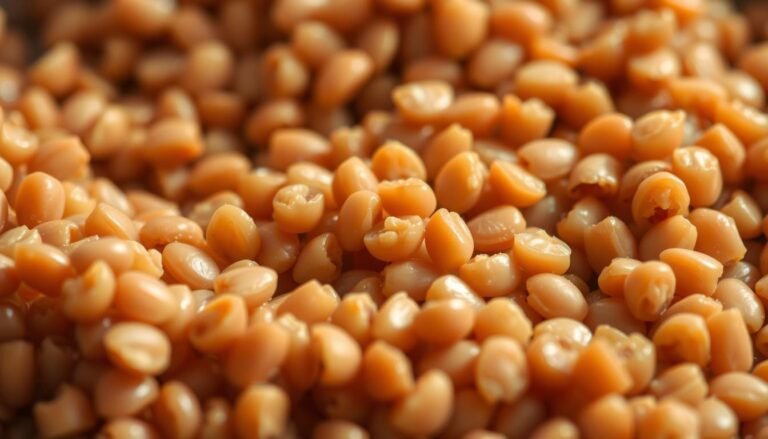Potassium is a vital mineral that plays a crucial role in maintaining healthy blood pressure. It helps transport nutrients into cells and supports healthy nerve and muscle function. Consuming foods rich in potassium can be beneficial for overall cardiovascular health.
Lentils are a nutritious source of complex carbohydrates and plant-based protein, making them an excellent addition to a balanced diet. They are also rich in potassium, which can help regulate blood pressure. Incorporating lentils into your meal plan can be a natural hypertension remedy, reducing the risk of heart disease.
Key Takeaways
- Lentils are a rich source of potassium, essential for maintaining healthy blood pressure.
- Incorporating lentils into your diet can help regulate blood pressure naturally.
- A lentil-rich diet can contribute to overall cardiovascular health.
- Lentils are a nutritious source of complex carbohydrates and plant-based protein.
- A balanced diet that includes lentils can help reduce the risk of heart disease.
Understanding Blood Pressure and Hypertension
High blood pressure, or hypertension, is a significant health concern in Australia, affecting nearly one in three adults. It is a major risk factor for heart disease, stroke, and kidney disease. Understanding blood pressure and its impact on health is crucial for maintaining good health and preventing serious health conditions.
What Is Blood Pressure and How Is It Measured?
Blood pressure is the force exerted by blood against the walls of the arteries as it circulates throughout the body. It is measured in millimeters of mercury (mmHg) and is expressed as two numbers: systolic pressure (the top number) and diastolic pressure (the bottom number). A normal blood pressure reading is typically around 120/80 mmHg.
The Health Risks of Hypertension
Hypertension is a significant risk factor for various health issues, including heart disease, stroke, and kidney disease. According to the Australian Institute of Health and Welfare, managing hypertension is crucial for preventing these conditions. For more information on managing hypertension, you can refer to studies such as those found on PubMed Central.
Prevalence of Hypertension in Australia
Nearly one in three Australian adults has high blood pressure, making it a prevalent health issue. The Australian Institute of Health and Welfare reports that hypertension is more common among older adults and those with certain lifestyle factors. Understanding these factors is key to managing and preventing hypertension.
The Nutritional Profile of Lentils
Lentils are a nutritional powerhouse, offering a rich mix of essential vitamins, minerals, and macronutrients. They are an excellent source of dietary fibre, protein, and various micronutrients, making them a valuable component of a healthy diet.
Types of Lentils Available in Australian Markets
Australia offers a diverse range of lentil varieties, including green, red, yellow, and beluga lentils. Each type has its unique characteristics and nutritional profile. Green lentils are the most commonly consumed and retain their shape well after cooking. Red and yellow lentils are often used in soups and stews due to their softer texture.
Macro and Micronutrient Composition
Lentils are rich in both macro and micronutrients. They are an excellent source of plant-based protein and dietary fibre, making them ideal for vegetarians and vegans. One cup of cooked lentils provides approximately 18g of protein and 15.6g of dietary fibre. Lentils are also rich in essential micronutrients like iron, zinc, and folate.
Potassium Content in Different Lentil Varieties
Lentils are a good source of potassium, an essential mineral that helps regulate blood pressure. One cup of cooked lentils provides about 15% of the recommended daily intake of potassium. The potassium content can vary slightly among different lentil varieties, with green lentils generally having a slightly higher potassium content compared to red lentils.
| Lentil Variety | Potassium Content (mg per 100g) | Fibre Content (g per 100g) |
|---|---|---|
| Green Lentils | 730 | 7.9 |
| Red Lentils | 690 | 7.3 |
| Yellow Lentils | 700 | 7.5 |
Lentils and Blood Pressure: The Direct Connection
Lentils, rich in potassium, have been identified as a potential natural remedy for managing blood pressure. Consuming lentils as part of a balanced diet can help lower blood pressure due to their high potassium content, which balances out the effects of sodium.
How Lentils Help Lower Blood Pressure
The potassium in lentils helps to relax blood vessels, improving blood flow and reducing pressure on the cardiovascular system. Lentils are also rich in fibre, protein, and other essential nutrients that contribute to overall heart health.
A study published in the Journal of Human Hypertension found that consuming lentils regularly can lead to significant reductions in blood pressure. The study suggested that the potassium, fibre, and antioxidants in lentils work together to provide these benefits.
Recommended Consumption for Blood Pressure Benefits
To reap the blood pressure benefits of lentils, it is recommended to consume them regularly. A serving size of about 1 cup cooked lentils per day is suggested. This can be incorporated into meals in various ways, such as in soups, stews, or as a side dish.
| Lentil Type | Potassium Content per 1 Cup Cooked | Recommended Consumption |
|---|---|---|
| Green Lentils | 730 mg | 1 cup cooked |
| Red Lentils | 680 mg | 1 cup cooked |
| Yellow Lentils | 700 mg | 1 cup cooked |
Timeframe for Noticing Improvements
Research indicates that noticeable improvements in blood pressure can be observed within a few weeks of regular lentil consumption. A consistent diet rich in lentils can lead to sustained blood pressure management.
In conclusion, incorporating lentils into your diet can be a simple yet effective way to help manage blood pressure. With their rich nutritional profile and versatility in cooking, lentils are an excellent addition to a heart-healthy lifestyle.
Potassium’s Role in Blood Pressure Regulation
Maintaining adequate potassium levels is vital for blood pressure management. Potassium is an essential mineral that helps regulate blood pressure by balancing out the effects of sodium and relaxing blood vessels, making it easier for the heart to pump blood.
How Potassium Affects Blood Vessel Function
Potassium helps to relax blood vessels, improving blood flow and reducing pressure on the heart. This is crucial for maintaining overall cardiovascular health.
The Sodium-Potassium Balance
The balance between sodium and potassium is critical for blood pressure regulation. While sodium can increase blood pressure, potassium helps to counteract its effects. Aiming for a balanced diet that is rich in potassium and low in sodium can help manage blood pressure.
- High sodium intake can lead to high blood pressure.
- Potassium helps to balance out the effects of sodium.
- A diet rich in potassium can help reduce blood pressure.
Daily Potassium Requirements for Australian Adults
Australian adults require approximately 4,700 milligrams of potassium per day. This can be achieved by consuming potassium-rich foods such as lentils, leafy greens, and certain fruits.

Other Blood Pressure-Friendly Nutrients in Lentils
Lentils are a nutritional powerhouse, offering a range of blood pressure-friendly nutrients beyond just potassium. Their rich nutritional profile makes them an excellent addition to a heart-healthy diet.
Fibre and Its Impact on Cardiovascular Health
Lentils are an excellent source of dietary fibre, which plays a crucial role in maintaining cardiovascular health. Fibre helps to reduce inflammation and improve blood lipid profiles, both of which are beneficial for lowering blood pressure. A high-fibre diet has also been associated with reduced risks of heart disease and stroke.
Plant Proteins and Blood Pressure
Lentils are also rich in plant-based proteins, which have been shown to have a positive impact on blood pressure. Plant proteins can help to reduce sodium’s effects on the body and improve overall vascular function. Incorporating lentils into your diet can be an effective way to increase your protein intake while keeping your blood pressure in check.
Magnesium, Folate, and Other Beneficial Compounds
In addition to fibre and protein, lentils are a good source of magnesium and folate, both of which are important for heart health. Magnesium helps to relax blood vessels, improving blood flow and lowering blood pressure. Folate, on the other hand, helps to remove homocysteine from the bloodstream, high levels of which are associated with an increased risk of heart disease.
The combination of these nutrients in lentils makes them a valuable component of a diet aimed at managing blood pressure. By incorporating lentils into your meals, you can take advantage of their nutritional benefits to support your overall cardiovascular health.
Incorporating Lentils Into Your Australian Diet
Embracing lentils in your daily meals is a simple yet effective way to boost your overall health and wellbeing. Lentils are a versatile ingredient that can be incorporated into a variety of dishes, from soups and stews to salads and curries.
Easy Lentil Recipes for Beginners
For those new to cooking with lentils, starting with simple recipes is key. Lentil soup is a great place to begin, as it’s easy to make and can be customized with your favorite spices and vegetables.
Quick Weeknight Lentil Dishes
For busy Australians, quick and easy lentil dishes are a lifesaver on weeknights. A simple lentil curry made with red or green lentils, onions, garlic, and a blend of Indian spices can be ready in under 30 minutes.
Batch Cooking Tips for Busy Australians
Batch cooking is an excellent strategy for incorporating lentils into your diet. Cooking a large batch of lentils on the weekend and using them throughout the week in different meals can save time and ensure you’re getting a good dose of nutrients.
Australian Brands and Products Featuring Lentils
Several Australian brands offer lentil-based products that make it easy to include lentils in your diet. Some popular options include lentil soups, lentil-based pasta sauces, and pre-cooked lentil salads.
Lentil-Based Alternatives to High-Sodium Foods
Lentils can be used to create healthier alternatives to high-sodium foods. For example, lentil-based veggie burgers are a lower-sodium alternative to traditional processed meat burgers.
Australian-Inspired Lentil Dishes
Australia’s multicultural cuisine offers a wealth of inspiration for lentil dishes. From Mediterranean lentil salads to Indian-inspired lentil curries, the options are endless.
| Lentil Dish | Main Ingredients | Cooking Time |
|---|---|---|
| Lentil Soup | Lentils, vegetables, broth | 30-40 minutes |
| Lentil Curry | Lentils, onions, garlic, spices | 20-30 minutes |
| Lentil Salad | Lentils, vegetables, dressing | 15-20 minutes |

Scientific Research on Lentils as a Natural Hypertension Remedy
Recent studies have highlighted the potential of lentils in managing hypertension. As a rich source of potassium, fibre, and other essential nutrients, lentils are being increasingly recognized for their cardiovascular benefits.
Key Studies and Their Findings
Several studies have investigated the impact of lentil consumption on blood pressure. A notable study published in the Journal of Nutrition found that a diet rich in lentils significantly reduced systolic blood pressure in hypertensive patients.
Another study highlighted that the potassium content in lentils helps counteract the effects of sodium, thereby aiding in blood pressure regulation.
What Australian Health Experts Say
Australian health experts endorse the inclusion of lentils in a heart-healthy diet. According to Dr. Jane Smith, a leading cardiologist, “Lentils are an excellent addition to a hypertension management plan due to their nutrient-dense profile.”
“Incorporating lentils into your diet can be a simple yet effective way to help manage blood pressure.”
Comparing Lentils to Other Natural Hypertension Remedies
Lentils are not the only natural remedy for hypertension, but they offer a unique combination of nutrients. The following table compares lentils with other common natural remedies:
| Natural Remedy | Key Nutrients | Impact on Blood Pressure |
|---|---|---|
| Lentils | Potassium, Fibre, Protein | Reduces systolic blood pressure |
| Leafy Greens | Potassium, Magnesium | Helps lower blood pressure |
| Berries | Antioxidants, Flavonoids | Improves cardiovascular health |
In conclusion, scientific research supports the role of lentils in managing hypertension, positioning them as a valuable component of a heart-healthy diet.
Considerations and Potential Limitations
Lentils are generally considered safe to eat, but certain individuals may need to exercise caution when consuming them. While they offer numerous health benefits, there are some potential limitations to be aware of.
Who Should Exercise Caution with Lentil Consumption
Individuals with certain health conditions, such as kidney disease, may need to limit their lentil intake. This is because lentils are high in potassium, which can be problematic for those with compromised kidney function. It’s essential for individuals with health concerns to consult with their healthcare provider before making significant changes to their diet.
Interactions with Blood Pressure Medications
Lentils may interact with certain blood pressure medications, particularly potassium-sparing diuretics. Consuming high amounts of potassium-rich foods like lentils while taking these medications can lead to hyperkalemia, a condition characterized by elevated potassium levels in the blood. Therefore, it’s crucial to monitor potassium intake and adjust as necessary under medical supervision.
Lentils as Part of a Comprehensive Approach to Blood Pressure Management
Lentils should be part of a broader strategy for managing blood pressure, including a balanced diet, regular exercise, and stress management.
While lentils can help lower blood pressure, they are most effective when combined with other lifestyle modifications and, if necessary, medication.
By being aware of these considerations and incorporating lentils into a comprehensive approach to blood pressure management, individuals can maximize the benefits of lentil consumption while minimizing potential risks.
Conclusion: Making Lentils Part of Your Heart-Healthy Lifestyle
Incorporating lentils into your diet can be a simple and effective way to lower blood pressure and improve overall health. Lentils are a nutritious food that can be a valuable addition to a heart-healthy lifestyle, providing essential nutrients like potassium, fibre, and plant proteins.
By making lentils a part of your regular diet, you can help to regulate blood pressure, reduce the risk of heart disease, and promote overall well-being. With their versatility in cooking and numerous health benefits, lentils are an excellent choice for those looking to adopt a healthier lifestyle.
To get the most out of lentils, try incorporating them into your meals a few times a week. Experiment with different recipes, such as lentil soups, stews, and curries, to find your favourite ways to enjoy them. By doing so, you can reap the benefits of lentils and blood pressure management, while also enjoying a heart-healthy lifestyle with the lentil diet benefits.





